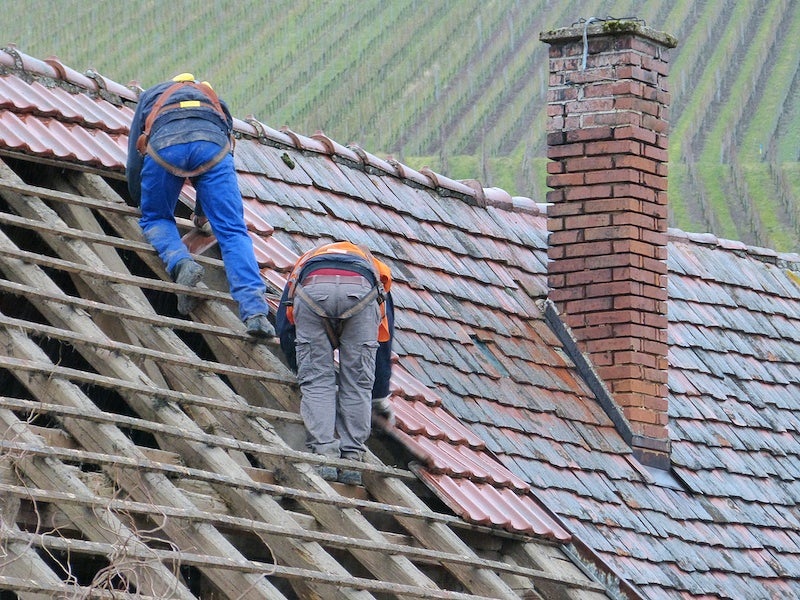Discover the tell-tale signs that your roof ridge tiles need attention before costly damage occurs
Understanding Roof Ridge Tiles
Roof ridge tiles are critical components of your roofing system, serving as the protective crown where roof slopes meet at the highest point. These specialised tiles, typically measuring 16-20 inches in length, play a vital role in preventing water ingress and maintaining your roof’s structural integrity. In the UK’s variable climate, properly installed and maintained ridge tiles are essential for protecting your home against our frequent rain and wind. Recent studies show that **over 60% of serious roof leaks** begin with compromised ridge tiles, making their maintenance crucial for any property owner.
Key Signs Your Ridge Tiles Need Replacement
- Visible Cracks or Splits: Inspect for any fractures or breaks in the tiles, particularly after severe weather
- Loose or Missing Tiles: Any movement or gaps in the ridge line requires immediate attention
- Mortar Deterioration: Crumbling or missing mortar between tiles indicates urgent repair needs
- Water Stains: Brown patches on upper walls or ceilings suggest water penetration
- Daylight Visible: Check your loft – if you can see daylight through the ridge, immediate action is required
- Age-Related Wear: Most ridge tiles last 20-30 years; older installations may need replacement
- Moss or Vegetation Growth: Excessive growth can indicate moisture retention and degradation
Common Types of Ridge Tile Damage
Understanding the various forms of ridge tile damage helps in early problem identification. Frost damage is particularly common in the UK, with **approximately 40% of ridge tile replacements** being frost-related. This occurs when water penetrates tiny cracks, freezes, and expands, causing larger fissures. Wind damage is another significant issue, especially in coastal areas where gusts can exceed 70mph, potentially lifting and displacing tiles. Chemical degradation from air pollution affects urban properties more severely, while biological damage from moss and lichen growth can accelerate wear in rural settings.
The Risks of Delayed Replacement
Postponing necessary ridge tile replacement can lead to severe consequences. Recent industry data shows that **delayed repairs typically result in costs 3-4 times higher** than immediate intervention. Water infiltration can cause extensive damage to roof timbers, with average repair costs reaching £3,000-£5,000. Additionally, compromised ridge tiles can affect your home’s energy efficiency, potentially increasing heating costs by up to 25% due to heat escape through the roof. Insurance claims may also be rejected if maintenance neglect is identified as a contributing factor.
Professional Assessment vs DIY Inspection
While regular visual checks from ground level are recommended, professional inspection provides comprehensive evaluation. Experts suggest annual professional assessments, particularly for properties over 15 years old. DIY inspections should focus on obvious signs visible from the ground or through loft spaces, but climbing onto roofs should be left to qualified professionals. Recent safety statistics indicate that **40% of domestic accidents** involve DIY roof work, emphasising the importance of professional intervention.
Replacement Options and Materials
- Traditional Clay Tiles: Excellent durability, authentic appearance, 60+ year lifespan
- Concrete Ridge Tiles: Cost-effective, various profiles, 40-50 year lifespan
- Composite Materials: Lightweight, easy installation, 30-40 year lifespan
- Ventilated Options: Incorporate roof ventilation, reducing condensation risks
- Dry Ridge Systems: Modern alternative to traditional mortar fixing
The Replacement Process
Professional ridge tile replacement typically takes 1-2 days, depending on roof size and complexity. The process begins with careful removal of existing tiles and thorough cleaning of the ridge line. Modern installation methods often utilise dry ridge systems, which **studies show are 40% more reliable** than traditional mortar bedding. Weather-proof underlayment is installed, followed by precise positioning of new ridge tiles. Professional installers ensure proper overlap and secure fixing, essential for long-term performance.
Maintenance Tips for Longevity
Regular maintenance can significantly extend ridge tile lifespan. Annual visual inspections, particularly after severe weather, help identify early issues. Keep gutters clear to prevent water backup, and remove excessive moss growth. Professional cleaning every 3-5 years can prevent debris accumulation and allow for early problem detection. Statistics show that **well-maintained ridge tiles last 25% longer** than those left unchecked.
Cost Considerations and Value
Ridge tile replacement typically costs between £30-£50 per metre in the UK, with complete ridge replacement for an average semi-detached house ranging from £800-£1,200. While this might seem significant, it represents just 15% of the cost of potential water damage repairs. Investment in quality materials and professional installation often provides better value, with premium solutions offering up to 30% longer lifespan. Consider that proper ridge tile maintenance can increase property value by maintaining structural integrity and aesthetic appeal.
Making the Right Choice
Deciding on ridge tile replacement requires careful consideration of multiple factors. Assess your property’s age, current tile condition, and local weather exposure. Choose materials that complement your existing roof while providing optimal protection. Professional installation ensures proper fitting and weatherproofing, crucial for long-term performance. Remember, proactive replacement of deteriorating ridge tiles typically saves **60-70% compared to emergency repairs** and associated damage costs. Contact qualified local specialists for detailed assessment and tailored solutions suited to your property’s specific needs.
FAQ
Should ridge tiles be screwed down?
Dry fix ridge systems use nails, screws, unions, clamps, and brackets to keep the tiles in place. This mortar-free method is now the norm, and is preferred for compliance reasons (we’ll discuss the requirements of BS 5534:2014 + A2:2018 in the next section).
How long should ridge tile mortar last?
Speaking in general terms you can expect a ridge tile to last for around 40 years before it will need to be removed and the mortar cleared.
How should ridge tiles be secured?
Where masonry walls support or abut ridge, all ridge tiles within 900mm of such walls must be mechanically secured. Fix to supplementary ridge tile fixing batten with nails, clips or wire, etc, as recommended by manufacturer. Fill ends of ridges at gables with mortar and slips of tiles finished flush.
Do roof ridge tiles need pointing?
The shape of the roof ridge caps will usually be curved or sloped to help rainwater run down the sides of your roof. However, the bedding and pointing of the roof ridge need to be maintained to protect and secure your roof.
Are dry ridge tiles better than cement?
This is because a dry ridge system is mortar free and each tile is mechanically attached, making the whole system is much stronger and able to withstand extreme weather conditions, requiring minimal to no maintenance over the lifespan of the roof.
Sources
[1] https://heckerridgetiles.com
[2] https://www.theroof.store/product/composite-spanish-barrel-hip-ridge-rake-tile
[3] https://www.youtube.com/watch?v=DMMkwvLa6bs



